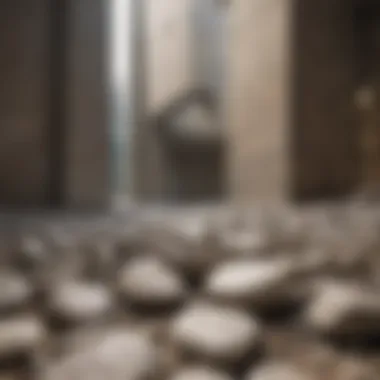Exploring Manmade Stones: Composition and Applications


Intro
The study of manmade stones offers a compelling intersection of art, science, and technology. These materials, often engineered to mimic natural stones, have gained recognition in various sectors, reflecting both aesthetic values and functional applications. As technology advances, manufactured stones are becoming increasingly sophisticated, drawing attention from collectors, architects, and environmentalists alike. Understanding their composition, applications, and ecological implications is critical, especially in a time where sustainability and innovation converge. This article aims to explore these dimensions, providing valuable insight into manmade stones and their significance in our lives and the environment.
History and Origins
Overview of Manmade Stones
Manmade stones have origins that date back to the early 20th century when advancements in material science began to facilitate the creation of synthetic alternatives to natural stones. Examples include terrazzo and engineered quartz, both of which have found their way into residential and commercial applications. The drive for such innovations was partly due to the growing demand for durable and versatile materials in construction and design.
The use of synthetic materials has expanded significantly, propelled by the construction industry’s need for sustainable practices. The increasing awareness of ecological issues has led to a focus on materials that minimize waste and environmental impact. Manufacturers now utilize recycled materials and innovative techniques to produce high-quality manmade stones that can compete aesthetically and functionally with their natural counterparts.
Historical Significance and Cultural Impact
The cultural significance of manmade stones is multifaceted. From an artistic perspective, they offer unlimited design possibilities, enabling architects and designers to push creative boundaries. In regions where natural stone is scarce, manmade alternatives provide solutions that respect cultural heritage while embracing modernity. Furthermore, the evolution of these materials has implications for sustainability, as many products are designed to be eco-friendly, aligning with contemporary values.
Manmade stones have transcended their initial industrial applications to become essential components in art and architecture. Iconic structures around the world now utilize these materials, showcasing their versatility and durability. Artists and designers increasingly incorporate manmade stones in sculptures and installations, showcasing their potential beyond traditional uses.
Identification and Classification
Guide to Identifying Manmade Stones
Identifying manmade stones can be challenging, but there are key characteristics to consider:
- Texture: Many manmade stones have a consistent texture, whereas natural stones typically exhibit variations and imperfections.
- Color: Synthetic stones often come in a wider range of colors due to dyeing processes. In contrast, natural stones usually have earth-toned colors.
- Weight: Engineered stones may be lighter than their natural equivalents due to the use of fillers and resins.
Common Types and Variations
Manmade stones can be classified into several categories, each with unique properties and applications:
- Quartz Surfaces: Composed mainly of crushed quartz mixed with resins, quartz surfaces are popular for countertops due to their durability.
- Terrazzo: A composite material made from chips of marble, glass, or other aggregates poured with a cement binder. Terrazzo is known for its decorative appeal.
- Glass Stone: Crafted from recycled glass, glass stone offers an eco-friendly option with vibrant colors and translucency.
"Manmade stones represent more than just an innovation; they signify a shift towards sustainable materials that align with contemporary architectural needs."
Prelims to Manmade Stones
Manmade stones represent an intriguing frontier in material science, merging human innovation with aesthetic and practical applications. These materials have gained significance across various sectors, particularly in construction, art, and interior design. Understanding the foundations of manmade stones is essential as we explore their composition and applications. This section introduces the concept and highlights key elements that underscore their importance.
Defining Manmade Stones
Manmade stones are synthetic materials engineered to mimic the appearance and properties of natural stones. These materials are composed of various aggregates: resins, pigments, and other additives, which are combined to create stones that can match or surpass the qualities of their natural counterparts.
Typically, these stones are categorized into varieties, including cultured marble, reconstituted stone, engineered quartz, and glass composites. The intrinsic value of manmade stones lies in their versatility, durability, and aesthetic appeal. They can be fashioned into numerous designs and finishes, making them suitable for a wide range of applications.
One defining feature is the controlled production process, which allows for enhanced performance characteristics. For example, engineered quartz is known for its resistance to scratching and staining, while cultured marble is favored for its unique veining and rich colors.
Historical Context and Development
The history of manmade stones can be traced back several decades, with initial developments highlighting the need for materials that could provide economical and sustainable alternatives to natural stone. The inception of synthetic stones began in the early 20th century, primarily driven by the advancements in chemistry and industrial processes.
During this period, the first successful combinations of stone aggregates and resins emerged, resulting in early forms of cultured marble and other engineered materials. As technology progressed, more sophisticated methods of production evolved, enhancing the quality and aesthetics of these materials.
By the late 20th century, the adoption of manmade stones expanded significantly within architectural and design circles. Today, they are not just seen as substitutes but are valued for their unique properties and contributions to modern design aesthetics. The evolution of manmade stones reflects broader trends in sustainability and technological innovations, continuing to redefine industry standards.
"Manmade stones exemplify how human ingenuity can enhance both functional and environmental aspects of building materials."
In summary, the introduction of manmade stones is pivotal for understanding their role in contemporary applications. A comprehensive analysis of their composition, historical development, and significance reveals a dynamic balance between innovation and tradition.
Types of Manmade Stones
Understanding the various types of manmade stones is crucial for appreciating their roles in construction, design, and art. Each category of manmade stone offers distinct benefits that cater to specific needs, whether in aesthetics, durability, or functionality. This section dissects the most prominent types of manmade stones, elaborating on their unique properties and applications, thus providing rock and fossil collectors, along with enthusiasts, with a deeper insight into these materials.


Cultured Marble
Cultured marble is a manufactured stone product that combines crushed marble and resin. It often features a glossy finish and can mimic the natural appearance of marble quite effectively. One of the main advantages of cultured marble is its versatility. It is commonly used in bathroom vanities, shower surrounds, and countertops.
Besides its aesthetic appeal, cultivated marble is relatively cost-effective compared to natural marble, allowing a wider audience access to an elegant look without the hefty price tag. Another aspect is that it is non-porous, which means it is resistant to stains and easier to maintain.
Reconstituted Stone
Reconstituted stone, often referred to as engineered stone, comprises 90-95% crushed stone elements that are bound together with resin. The blending of various materials allows for a broader range of colors and textures than might be found in nature. This attribute is beneficial for designers aiming for a specific visual effect in applications such as countertops, flooring, and wall cladding.
Environmental considerations also come into play, as many manufacturers produce reconstituted stone from recycled materials. This sustainability aspect changes the game, appealing to eco-conscious consumers. Additionally, reconstituted stone shares the durability of natural stones, making it suitable for high-traffic areas.
Engineered Quartz
Engineered quartz is another popular form of manmade stone. Made primarily from quartz crystals and resin, it offers high durability and resistance to scratching. This material is non-porous, which enhances its hygiene and makes it ideal for kitchens and bathrooms. Unlike natural stone, such as granite or marble, engineered quartz does not require sealing, thus saving time and effort in maintenance.
A key feature of engineered quartz is the uniformity in appearance, which can be appealing for those who prefer a consistent aesthetic. Its colors and patterns are vast, often imitating the look of natural stones while providing additional design-based flexibility that is particularly valuable for interior designers.
Glass and Crystal Composites
Glass and crystal composites combine recycled glass with resin or other bonding agents to create a visually striking surface. These materials often feature vibrant colors and can reflect light in unique ways, making them a favorite in contemporary design. They are commonly used for countertops, decorative pieces, and flooring.
The sustainability aspect of glass composites appeals to eco-friendly consumers as well. Since they utilize recycled materials, their production has a lower environmental footprint than some traditional stone options. Apart from aesthetic qualities, glass composites are also scratch-resistant and easy to clean, which enhances their practicality in various applications.
"Manmade stones not only serve functional purposes but also reflect contemporary design principles, merging sustainability with aesthetics."
Manufacturing Processes
The manufacturing processes utilized in the creation of manmade stones are integral to their distinct characteristics and versatility. A well-understood and optimized manufacturing process can enhance the final product's durability, appearance, and application suitability. By focusing on specific elements like raw material selection, formation techniques, and finishing processes, manufacturers can produce manmade stones that not only mimic natural ones but also exceed them in certain aspects. This section breaks down the key manufacturing processes, revealing their importance in the context of the overall topic.
Raw Material Selection
Raw material selection is a critical stage in the production of manmade stones. The materials chosen directly influence the physical properties of the final products, such as strength, aesthetic appeal, and ecological footprints. Commonly used raw materials include resins, minerals, and aggregates. Each material comes with its own set of properties.
- The right combination can significantly enhance the stone’s durability and appearance.
- The choice of materials also impacts production costs and environmental sustainability.
Selecting high-quality raw materials can lead to superior products, catering to a refined audience that values both aesthetics and functionality in their stone applications.
Formation Techniques
Compression
Compression is a prevalent formation technique in producing manmade stones. This method involves applying pressure to a mix of raw materials to induce a uniform and dense formulation. Its main beneficial aspect is the achievement of consistent density across the material.
- Key characteristic: High strength and durability due to the uniform density achieved.
- Unique feature: Works well with various materials, allowing for flexibility in design.
- Advantages: This technique is efficient for large-scale production and results in high-quality stones ideal for numerous applications in construction and design.
- Disadvantages: The process may require substantial energy input and machinery, increasing overall production costs.
Casting
Casting involves pouring a liquid mixture of raw materials into molds, where it solidifies into the desired shapes. This method is crucial for creating intricate designs and detailed textures in manmade stones.
- Key characteristic: Allows for a high level of customization, making it easy to achieve various shapes and styles.
- Unique feature: Excellent for replicating the appearance of natural stones.
- Advantages: This process is favored for artistic applications and custom jobs, as it offers flexibility in design.
- Disadvantages: There can be longer curing times compared to other processes, which may limit production speed.
Injection Molding
Injection molding is a technique that involves forcing a mixture of materials into a mold under pressure. This process is particularly advantageous for producing large quantities of identical stones quickly and efficiently.
- Key characteristic: High production speed and uniformity in product shape and size.
- Unique feature: Capable of producing complex shapes that may be challenging with other methods.
- Advantages: Efficient for high-volume production runs, reducing per-unit costs significantly.
- Disadvantages: Initial setup costs can be high due to the need for specialized machinery and molds.
Finishing Processes
Finishing processes play a crucial role in enhancing the aesthetics and functionality of manmade stones after formation. The finishing stages include polishing, sealing, and coating, each contributing uniquely to the final product.
Polishing


Polishing refers to the process of smoothing and shining the surface of manmade stones. This step is vital for enhancing the visual appeal of the finished product.
- Key characteristic: Creates a glossy surface that emphasizes color and patterns.
- Unique feature: Improves resistance to scratches and stains, increasing longevity.
- Advantages: Polished stones are favored in high-end interior applications due to their luxurious look.
- Disadvantages: Excessive polishing can lead to the loss of texture, which may be desired in some designs.
Sealing
Sealing is the process of applying a protective layer to manmade stones. This layer serves to protect the stone from stains, moisture, and wear.
- Key characteristic: Enhances durability and reduces absorption of liquids.
- Unique feature: Can be tailored to different environments depending on the intended use of the stone.
- Advantages: Extends the life of the stone and maintains its appearance over time.
- Disadvantages: Sealing requires periodic reapplication, adding to maintenance efforts.
Coating
Coating involves applying additional materials to the surface of the stones for enhanced performance or aesthetic appeal. Different coatings can provide various benefits, such as UV protection or decorative finishes.
- Key characteristic: Offers customizable finishes for different applications.
- Unique feature: Can be used to provide specific characteristics like slip resistance.
- Advantages: Versatile in its applications; coatings can significantly improve usability for specific environments.
- Disadvantages: May add layers that obscure texture or natural appearance if not carefully applied.
"Understanding these manufacturing processes not only informs about the quality of manmade stones but also enlightens the consumer on what to expect in terms of performance and longevity."
This exploration of manufacturing processes sets the stage for understanding how manmade stones are crafted and manipulated to meet modern demands across various fields.
Applications of Manmade Stones
The applications of manmade stones extend beyond mere aesthetic appeal; they contribute significantly to various industries, offering versatility, durability, and cost-effectiveness. Understanding these applications highlights their role in modern construction, design, and art, showcasing why they have become integral to contemporary practices. As industries lean towards sustainable solutions, manmade stones represent a practical alternative, reducing the demand for natural resources and promoting eco-friendly practices.
Construction and Architecture
In construction and architecture, manmade stones play a critical role. They provide a variety of benefits, such as reduced weight in building materials, which can improve structural efficiency. These stones can mimic the appearance of natural stones, offering aesthetic qualities without the associated costs or environmental impact.
Interior Design
Countertops
Countertops made from manmade stones have gained popularity due to their robustness and versatility. A significant aspect of countertops is their resistance to stains and scratches, which makes them highly desirable for high-traffic areas. Quartz-based countertops, for example, offer a non-porous surface, preventing bacteria growth and making them easy to clean. One unique feature is the variety of designs available, enabling customization that fits any decor style. However, while they can be more affordable than natural stone, the initial investment may still be higher compared to some laminated surfaces.
Flooring
Manmade stones in flooring applications provide outstanding durability and resilience. They are a beneficial choice as they resist wear, making them suitable for both residential and commercial settings. The key characteristic of flooring options like engineered stone is their ability to replicate the look of natural stone while being lighter and easier to install. One advantage is the availability of varied textures and colors, allowing for a unique design that enhances any space. A disadvantage could be a hardness that, while durable, may not provide the same warmth as traditional wood flooring.
Wall Cladding
Wall cladding made from manmade stones serves both functional and aesthetic purposes. This application is important for improving insulation and soundproofing in buildings. The versatile designs and easy installation of products such as reconstituted stones make them a popular choice for both interiors and exteriors. A unique feature is their capacity to endure harsh weather conditions without fading or deteriorating. However, the heavier weight compared to traditional wall coverings could require more robust supporting structures.
Art and Sculpture
Manmade stones are used in art and sculpture, allowing artists to explore innovative creations without limitations posed by natural stone. The flexibility in shaping and forming these materials can lead to unique artistic expressions. For sculptors, engineered stones provide the advantage of predictable consistency in color and texture, which can enhance the design process. However, the aesthetic and tactile experience of working with manmade materials might differ significantly from natural stones, which can impact the artist’s final work.
"The shift towards using manmade stones in both art and architecture signifies a growing recognition of their potential and versatility."
In essence, manmade stones hold extensive applications across various sectors. Their unique properties, combined with their adaptability, align perfectly with modern needs for sustainability, aesthetics, and performance. Engaging with these materials opens up possibilities for innovation in both design and art.
Ecological Considerations
Ecological considerations are vital when discussing manmade stones. As the world becomes more aware of environmental issues, examining how these materials align with sustainability goals is key. Manmade stones can provide various benefits, but their production and lifecycle also raise important questions. This section will analyze sustainability issues, the environmental impact of their production, and lifecycle analysis to understand better the broader implications of manmade stones.
Sustainability Issues
Sustainability in the context of manmade stones is multifaceted. First, consider the resources used in their production. Many manmade stones utilize recycled materials, which can reduce the demand for natural resources. For instance, engineered quartz often incorporates leftover materials from natural stone production. This practice can decrease waste and promote circular economies.
Furthermore, manmade stones generally demand less energy in production compared to extracting and processing natural stones. However, there is complexity in their sustainability. The source of energy used in their production can influence their overall carbon footprint. Therefore, assessing the energy mix and methods in production is critical for a complete sustainability evaluation.
Key points to examine include:


- Resource utilization: Using recycled materials can help reduce overall environmental impact.
- Energy consumption: Lower energy requirements play a positive role in sustainability, but the energy source matters.
Environmental Impact of Production
The production of manmade stones can have significant environmental effects. While they often have a smaller footprint than natural stone extraction, issues still exist. Chemical components used in some processes can lead to pollution if not managed properly. For example, resin in engineered quartz requires careful handling to avoid contaminating water sources.
Moreover, the location of manufacturing plays a role. Facilities near urban areas may contribute to local pollution and traffic congestion. Analyzing the geographic impact of production facilities is essential.
Important considerations include:
- Pollutants: Harmful emissions might result from manufacturing processes.
- Resource depletion: Direct extraction of raw materials can still have negative consequences.
"To achieve true sustainability, we need to focus on both environmental performance and resource-efficient production of manmade stones."
Lifecycle Analysis
Lifecycle analysis (LCA) is a critical tool for assessing the overall impact of manmade stones from creation to disposal. This systematic approach evaluates all stages, from raw material extraction to production, use, and eventual disposal. An accurate lifecycle analysis provides insights into potential environmental benefits or drawbacks.
In when examining manmade stones, thinking about:
- Production phase: Analysis of energy use and emissions during manufacturing.
- Usage phase: Durability and maintenance required during their functional lifespan contribute to overall impact.
- End-of-life: Options for recycling or disposal can significantly affect ecological footprints.
By taking an informed approach to production, use, and end-of-life strategies, stakeholders can better understand ecological considerations associated with manmade stones. Achieving a balance is essential to ensure sustainable practices align with the growing demand for these products.
Cultural Significance
The cultural significance of manmade stones spans various dimensions, reflecting their roles in art, architecture, and societal values. As a notable alternative to natural stones, these materials often embody innovation and human ingenuity. Their importance extends beyond mere aesthetics, as they influence the way societies express identity, creativity, and heritage through tangible forms. Understanding this significance can deepen appreciation for both the material and its applications.
Symbolism in Art and Culture
Manmade stones have become symbols of modernity in artistic expressions and cultural heritage. They are not just building blocks; they tell stories about progress and adaptability. For artists, these materials allow exploration of new forms and techniques, offering endless possibilities in sculpture and design. Engineers and architects are also drawn to manmade stones for their versatility and durability.
The symbolism can be categorized into several aspects:
- Identity: Manmade stones can reflect local culture and identity. For instance, cities often use specific types for public installations, demonstrating pride in local craftsmanship.
- Creativity: Artists utilize manmade stones in various mediums, merging traditional methods with contemporary designs. This encourages innovation in form and function.
- Sustainability: As the world shifts towards eco-friendliness, the use of recycled materials in manmade stones embodies a commitment to sustainability. This cultural ethos resonates with many communities, aiming for preservation of both art and environment.
Manmade Stones in Historical Context
Historically, manmade stones have evolved significantly, mirroring the broader trends in society and technology. From the early 20th century, when concrete became popular, to the recent innovation in engineered stone, each step represents a response to cultural needs and technical advancements.
- Early Developments: The advent of industrialization led to the burgeoning use of concrete and composites. This was a shift from reliance on natural stones, allowing for more structural flexibility and design creativity.
- Post-World War II: The reconstruction era saw a spike in the use of manmade stones. They became essential in rebuilding cities, reflecting a society eager to rejuvenate.
- Current Trends: Today, the artistic usage of manmade stones has gained traction, particularly in contemporary art. Artists create pieces that challenge perceptions of materials and encourage dialogue about sustainability.
Ultimately, manmade stones serve as both a canvas and a resource, reflecting the human condition through their symbolic and practical applications.
Future of Manmade Stones
The future of manmade stones represents a vital aspect of material science, architecture, and ecological sustainability. As industries seek to balance aesthetic appeal with environmental responsibility, manmade stones emerge as critical players. In this section, we will explore the technological advancements, innovative applications, and shifts in market trends that define the trajectory of these materials.
Advancements in Technology
Technological innovation has revolutionized the manufacturing of manmade stones. New methods enhance durability, reduce production costs, and improve aesthetics. One significant advancement is in resin technology. Improved formulations now allow for better bonding, reducing the visibility of seams in engineered stones. Advances in computer-aided design (CAD) have led to precise cutting and finishing. This ensures that manmade stones can closely replicate the appearance of natural stones.
Another area of progress is in the adoption of sustainable practices during manufacturing. For instance, processes utilizing recycled materials and reducing energy consumption are becoming standard in many facilities. This shift not only improves the ecological footprint but also appeals to eco-conscious consumers who prioritize sustainability.
Innovative Uses
The versatility of manmade stones allows them to be applied in numerous innovative ways. Beyond traditional applications in construction, they are now used in unexpected areas such as:
- Art Installations: Artists are increasingly incorporating manmade stones into their work, blending technology with creativity.
- Furniture Design: The properties of materials like engineered quartz enable unique designs in furniture, allowing for intricate shapes and color patterns that were not feasible with natural stones.
- Landscaping: Outdoor applications include decorative elements in gardens and water features. The aesthetic flexibility of manmade stones can match various design styles, from minimalist to extravagant.
Such adaptations showcase not only the functional benefits of these materials but also their contribution to aesthetic value in both commercial and residential projects.
Market Trends
The market for manmade stones is continuously evolving. Factors influencing this include:
- Demand for Sustainable Materials: As environmental awareness escalates, consumers are increasingly seeking products that align with sustainable principles. This trend pushes manufacturers to innovate and market their eco-friendly approaches.
- Rising Aesthetic Preferences: Younger generations show a preference for stylish and modern designs, leading to higher demand for unique manmade stones with vibrant colors and patterns. In response, manufacturers are investing in R&D for new textures, colors, and finishes.
- Globalization and Trade: The expanding global market for construction materials has led to greater availability of manmade stones worldwide. This accessibility is driving competition and encouraging more businesses to enter the market.
As we consider the future, the integration of technological, ecological, and market factors creates a landscape rich with potential for manmade stones. Collectors and hobbyists can look forward to advancements that not only enhance the functionality of these materials but also deepen their cultural significance.



